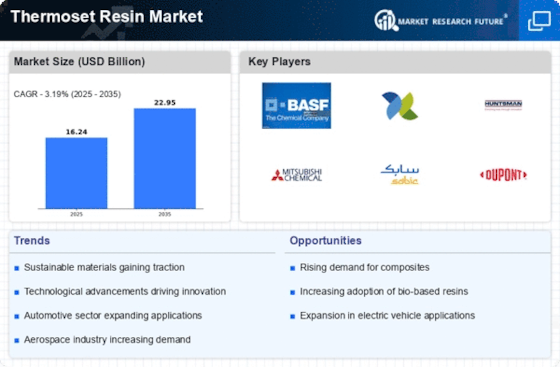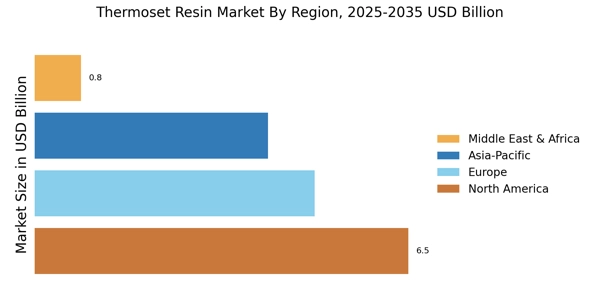The Thermoset Resin Market is currently characterized by a dynamic competitive landscape, driven by innovation, sustainability, and strategic partnerships. Key players such as BASF SE (Germany), Hexion Inc. (US), and Huntsman Corporation (US) are actively shaping the market through their distinct operational focuses. BASF SE (Germany) emphasizes innovation in product development, particularly in eco-friendly thermoset resins, which aligns with the growing demand for sustainable materials. Hexion Inc. (US) has adopted a strategy centered on mergers and acquisitions to enhance its technological capabilities and expand its product portfolio. Meanwhile, Huntsman Corporation (US) is focusing on regional expansion, particularly in Asia-Pacific, to capitalize on the increasing demand for thermoset resins in various industries, including automotive and construction. Collectively, these strategies contribute to a competitive environment that is increasingly focused on sustainability and technological advancement.
In terms of business tactics, companies are localizing manufacturing and optimizing supply chains to enhance efficiency and reduce costs. The market structure appears moderately fragmented, with several key players exerting influence over their respective segments. This fragmentation allows for a diverse range of products and innovations, although it also intensifies competition among established and emerging players. The collective influence of these key players is significant, as they drive trends and set benchmarks for quality and performance in the thermoset resin market.
In August 2025, Hexion Inc. (US) announced the acquisition of a specialty resin manufacturer, which is expected to bolster its product offerings and enhance its market position. This strategic move is likely to provide Hexion with access to advanced technologies and a broader customer base, thereby strengthening its competitive edge in the thermoset resin sector. The acquisition aligns with Hexion's ongoing commitment to innovation and market expansion, suggesting a proactive approach to meeting evolving customer needs.
In September 2025, Huntsman Corporation (US) launched a new line of bio-based thermoset resins aimed at reducing environmental impact. This initiative not only reflects the company's dedication to sustainability but also positions it favorably in a market increasingly driven by eco-conscious consumers. The introduction of these products may enhance Huntsman's reputation as a leader in sustainable materials, potentially attracting new customers and markets.
In October 2025, BASF SE (Germany) unveiled a digital platform designed to streamline the supply chain for thermoset resins, enhancing transparency and efficiency. This digital transformation initiative is indicative of the broader trend towards integrating technology into manufacturing processes. By leveraging digital tools, BASF aims to improve customer engagement and operational efficiency, which could set a new standard in the industry.
As of October 2025, the competitive trends in the Thermoset Resin Market are increasingly defined by digitalization, sustainability, and the integration of artificial intelligence. Strategic alliances are becoming more prevalent, as companies seek to leverage complementary strengths to enhance their market positions. Looking ahead, it appears that competitive differentiation will increasingly hinge on innovation, technological advancements, and the reliability of supply chains, rather than solely on price. This shift suggests a transformative phase in the market, where companies that prioritize these elements may emerge as leaders.


















Leave a Comment